The AMD Ryzen 9 7950X3D Review: AMD's Fastest Gaming Processor
by Gavin Bonshor on February 27, 2023 9:00 AM ESTCPU Benchmark Performance: Power And Office
Our previous sets of ‘office’ benchmarks have often been a mix of science and synthetics, so this time we wanted to keep our office section purely on real-world performance. We've also incorporated our power testing into this section too.
The biggest update to our Office-focused tests for 2023 and beyond include UL's Procyon software, which is the successor to PCMark. Procyon benchmarks office performance using Microsoft Office applications, as well as Adobe's Photoshop/Lightroom photo editing software, and Adobe Premier Pro's video editing capabilities. Due to issues with UL Procyon and the video editing test, we haven't been able to properly run these, but once we identify a fix with UL, we will re-test each chip.
We are using DDR5 memory on the Ryzen 9 7950X3D and the other Ryzen 7000 series we've tested. This also includes Intel's 13th and 12th Gen processors. We tested the aforementioned platforms with the following settings:
- DDR5-5600B CL46 - Intel 13th Gen
- DDR5-5200 CL44 - Ryzen 7000
- DDR5-4800 (B) CL40 - Intel 12th Gen
All other CPUs such as Ryzen 5000 and 3000 were tested at the relevant JEDEC settings as per the processor's individual memory support with DDR4.
Power
The nature of reporting processor power consumption has become, in part, a bit of a nightmare. Historically the peak power consumption of a processor, as purchased, is given by its Thermal Design Power (TDP, or PL1). For many markets, such as embedded processors, that value of TDP still signifies the peak power consumption. For the processors we test at AnandTech, either desktop, notebook, or enterprise, this is not always the case.
Modern high-performance processors implement a feature called Turbo. This allows, usually for a limited time, a processor to go beyond its rated frequency. Exactly how far the processor goes depends on a few factors, such as the Turbo Power Limit (PL2), whether the peak frequency is hard coded, the thermals, and the power delivery. Turbo can sometimes be very aggressive, allowing power values 2.5x above the rated TDP.
AMD and Intel have different definitions for TDP that are, broadly speaking, applied the same. The difference comes from turbo modes, turbo limits, turbo budgets, and how the processors manage that power balance. These topics are 10000-12000 word articles in their own right, and we’ve got a few articles worth reading on the topic.
- Why Intel Processors Draw More Power Than Expected: TDP and Turbo Explained
- Talking TDP, Turbo and Overclocking: An Interview with Intel Fellow Guy Therien
- Reaching for Turbo: Aligning Perception with AMD’s Frequency Metrics
- Intel’s TDP Shenanigans Hurts Everyone
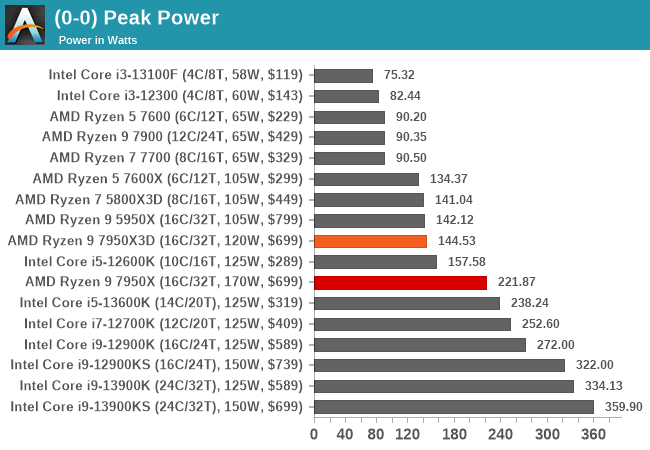
Given that the Ryzen 9 7950X3D has a lower TDP and PPT rating than the Ryzen 9 7950X, it pulls less power. We observed a peak power output of 144.53 W on the 7950X3D, compared to 221.87 W on the 7950X. Talking figures, the Ryzen 7950X3D is pulling around 65% of the power of the 7950X, which is understandable given the power limitations due to the CCX laden with AMD's 3D V-Cache packaging.
Looking at the power consumption of the Ryzen 9 7950X3D in closer detail, we can see that it delivered a consistent load of between 140 and 144 W in our Prime95 sustained power test. This is around 18 Watts lower than the official Package Power Tracking (PPT) level AMD has set at 162 W. However, it operates higher than the TDP of 120 W, which is to be expected. The TDP and PPT ratings are different as the TDP is the base power the CPU should be drawing, while the PPT (socket), set at 162 W, is the maximum the processor can draw as a maximum under full load.
Office/Web
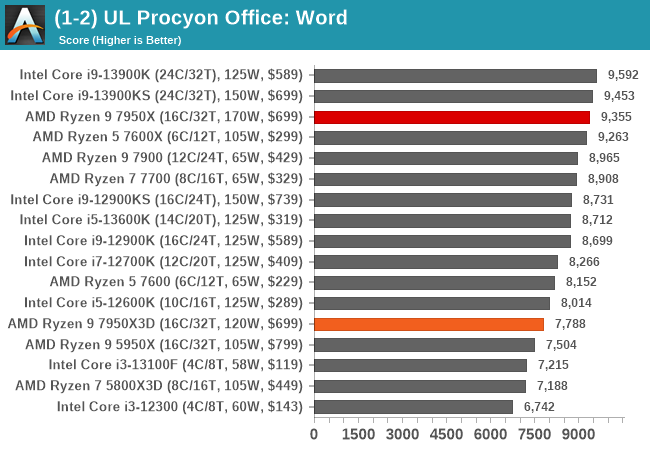
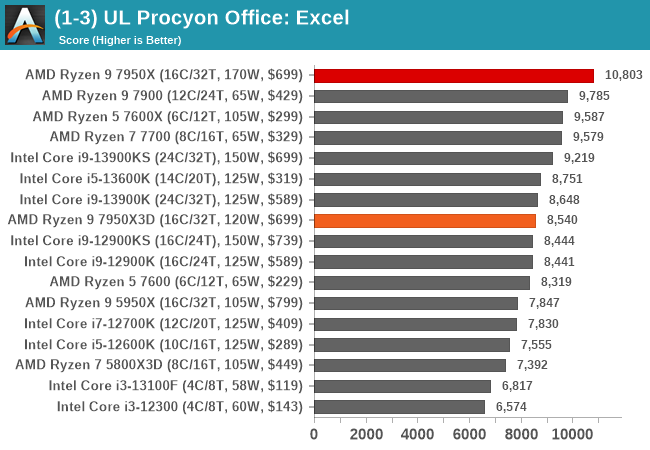
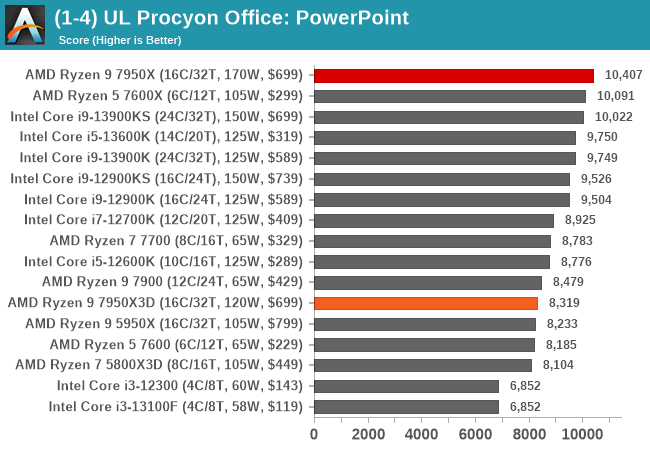
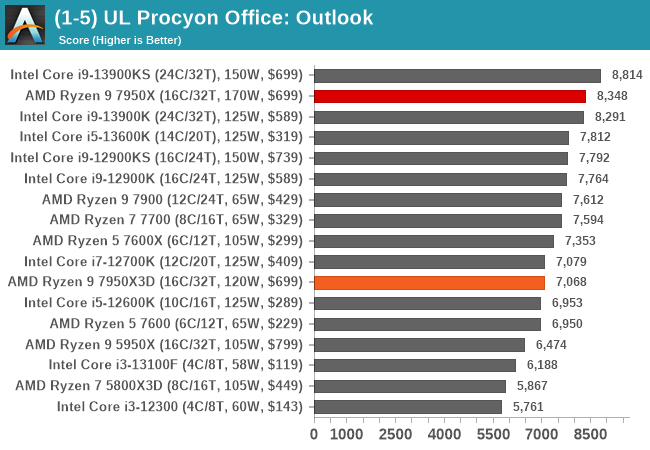
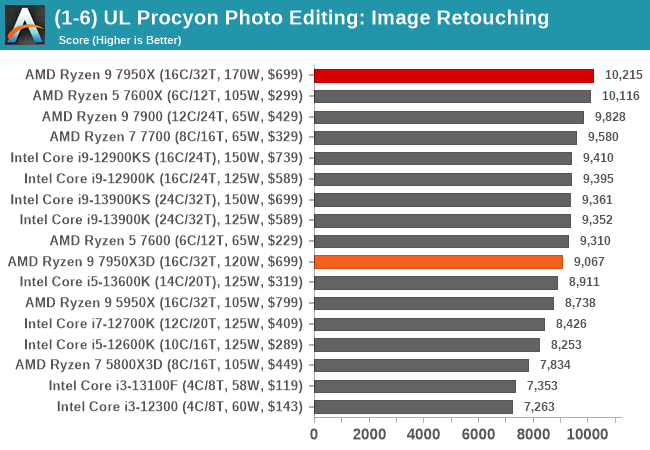
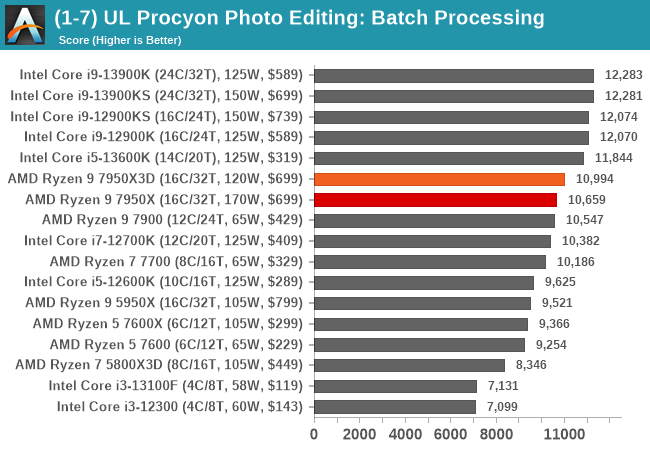
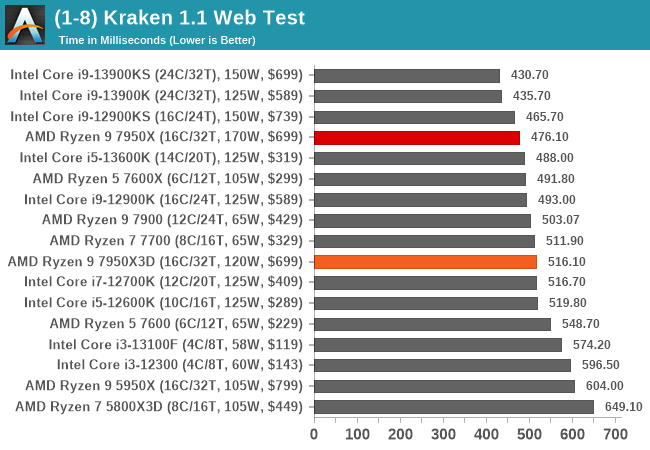
In our office-based testing, the Ryzen 9 7950X3D performs a little worse than the 7950X, but this is to be expected given the differences in TDP, PPT, and the overall power envelope. Still, the 7950X3D performs well and is more than suitable for office and web-based tasks.


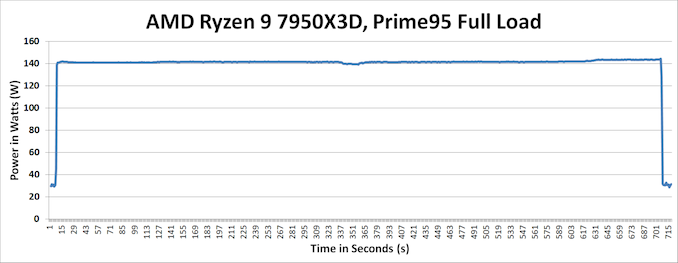








122 Comments
View All Comments
demian_thorne - Wednesday, March 1, 2023 - link
It is typical under articles and threads like this to hear and see all kinds of extreme opinions based on everyones personal pet peeves...I think your comment was the most sensible of them all ! Very well done !
milleron - Monday, February 27, 2023 - link
Thanks. For me, your testing suggests pretty strongly that I am best served by simply keeping my current 7800X3D rig — i.e., keep the current motherboard, 7800X3D, RAM, and SSDs but spend the money upgrading from an RTX 3080 to a 4080 or 4090. I WOULD like to see a test of MS Flight Simulator at 1440 and 4K before a final decision, but those should be forthcoming from the MFS forums soon enough.AvidGamer - Monday, February 27, 2023 - link
Do you happen to work for AMD or one of its system partners? If not you most likely intended to write 5800X3D right? After all the 7800X3D hasn't been released yet, at least not to my knowledge at the time of writing.milleron - Monday, February 27, 2023 - link
Sorry, regarding the above post, I currently have a 5800X3D rig, NOT a 7800X3D, which, obviously, does not currently exist. Too bad this website doesn't allow editing of comments.Gavin Bonshor - Monday, February 27, 2023 - link
The 5800X3D is still a VERY GOOD processor for gaming. And given it's around $330 right now and can be paired with DDR4 memory/AM4 motherboards, for the price, it'll be hard to beat for gamers on a budget.Of course, a discrete graphics card is required, but the more spent on a GPU, the better the gaming performance will be.
rb86 - Monday, February 27, 2023 - link
You said in the comments you're still doing testing. Will a new article be posted with your updated results or will this article be modified? These Factorio results are shockingly disappointing. Is there no way to force an application to start on the core with the 3D cache on it?Gavin Bonshor - Monday, February 27, 2023 - link
I certainly am, and they are running while I do my evening things. As the tidbit on the last page highlighted, Factorio performance SHOULD be higher, but AMD's PPM/3D V-Cache Performance Optimizer drivers didn't pick up the fact Factorio was running. This is primarily due to our benchmark that is running without a UI, and it's possibly why XBOX Game Bar didn't pick it up.On that note, I'll be doing more testing with the 7950X3D set to Cache and Frequency to see if AMD's drivers got it wrong on more in our test suite than just Factorio and possibly Dwarf Fortress.
As for if it will be an article update or a fresh page, I would say the update is more likely, but this will be explored when I have the data and if it makes THAT much of an impact on performance.
We shall see, but first, I need to collect more data.
flydian - Monday, February 27, 2023 - link
So far, all this has done is to sell me on the Ryzen 5 7600X. Maybe I'll wait for that 7800X3D before buying parts to upgrade from my 10th gen Intel CPU.meacupla - Monday, February 27, 2023 - link
the driver to park CPU cores to get windows to use the correct cores when gaming seems like such a hack workaround. I think AMD should have stuck to homogeneous cores, or gone the intel route and have a big-small configuration that the OS has an easier time of handling.Otritus - Monday, February 27, 2023 - link
The problem with big small is what is a big-core? Some workloads need higher frequency, others higher cache, and some a bit of both. I don’t understand why DirectX and Vulcan API calls couldn’t have been automatically routed to the V-cache CCD, and everything else to the frequency CCD. AMD clearly needed to spend more time optimizing the scheduler for their processors. Intel spent years building a new hardware scheduler and directly working with Microsoft to maximize performance.